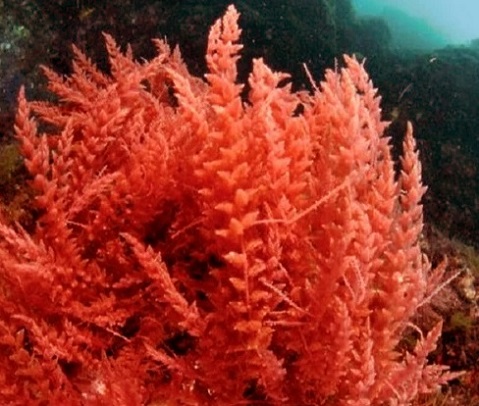Iota-Carrageenan Derived from Red Seaweed Inhibits Human Metapneumovirus (HMPV) Infections
Nikhil Prasad Fact checked by:Thailand Medical News Team Jan 08, 2025 11 months, 2 weeks, 6 days, 9 hours, 38 minutes ago
Medical News: Human metapneumovirus (HMPV), a pathogen responsible for severe respiratory illnesses, particularly among vulnerable populations such as infants, the elderly, and immunocompromised individuals, has been a focus of increasing concern. A groundbreaking study now reveals that the sulfated polysaccharide iota-carrageenan could play a pivotal role in curbing the spread of HMPV. This research, conducted by scientists from the University of Kentucky, Glycores 2000 S.r.l. in Milan, and the University of Turin-Italy, offers new hope in the fight against respiratory viral infections.
 Iota-Carrageenan Derived from Red Seaweed Inhibits Human Metapneumovirus
Iota-Carrageenan Derived from Red Seaweed Inhibits Human Metapneumovirus
(HMPV) Infections
The Threat of HMPV
HMPV was first identified in the Netherlands in 2001, although evidence suggests it has been causing respiratory infections since at least 1958. Nearly all individuals are exposed to this virus by the age of 10, with seropositivity rates nearing 100%. While children are among the most severely affected - making HMPV the second leading cause of pediatric hospitalizations due to respiratory infections - adults, particularly those with underlying health conditions, also face significant risks. Despite this, effective treatment and prevention options remain elusive.
Iota-Carrageenan as a Game-Changer
This
Medical News report explores the innovative use of iota-carrageenan, a compound derived from red seaweed, as a potential antiviral agent against HMPV. Known for its safety and previous application in human trials as a nasal spray against various respiratory viruses, iota-carrageenan’s mechanism involves targeting heparan sulfate (HS) proteoglycans on the cell surface. HS plays a critical role in facilitating the binding of HMPV’s fusion (F) protein, an essential step for the virus’s entry into human cells.
The study demonstrated that pre-treating HMPV with iota-carrageenan resulted in almost complete inhibition of viral infection in human bronchial epithelial cells. Remarkably, the effectiveness extended to complex models of human airway tissues, suggesting its potential for real-world applications. The researchers also emphasized that the compound's sulfated structure is crucial for disrupting the virus’s ability to bind to HS, effectively halting its replication cycle.
Additional Key Findings
The research team delved deeper into the structural specifics of HS that make it a binding target for HMPV. By experimenting with chemically modified polysaccharides mimicking HS, they identified O-sulfation as a critical factor for inhibiting viral attachment. This discovery underscores the specificity of the interaction between the HMPV F protein and HS, providing valuable insights for developing targeted antiviral therapies.
Moreover, the study explored the use of a peptide dendrimer, SB105-A10, designed to occlude HS sites on cell surfaces. This approach also showed promising results in reducing viral binding and infection. These findings collectively
highlight multiple avenues for antiviral intervention, leveraging the intricate details of HMPV’s entry mechanisms.
Implications for Antiviral Development
The implications of these findings are far-reaching. HMPV, like many respiratory viruses, relies on HS for initiating infection. The ability to disrupt this interaction using compounds like iota-carrageenan or HS mimetics opens new doors for broad-spectrum antiviral strategies. Additionally, the safety profile of iota-carrageenan, already validated in clinical settings, positions it as a viable candidate for rapid deployment in therapeutic contexts.
Study Conclusions
In conclusion, the study underscores the potential of iota-carrageenan and related compounds in mitigating the impact of HMPV infections. By targeting the virus’s reliance on HS for binding and entry, these interventions offer a strategic pathway to reduce infection rates and severity. While further research is needed to optimize these compounds for in vivo use, the findings mark a significant step forward in combating a virus that continues to pose a global health challenge.
The study findings were published in the peer-reviewed Journal of Virology.
https://journals.asm.org/doi/full/10.1128/jvi.01362-16
For the latest HMPV News, keep on logging to Thailand
Medical News.
Read Also:
https://www.thailandmedical.news/news/the-phytochemical-gamma-fagarine-from-the-root-of-zanthoxylum-bungeanum-is-an-effective-antiviral-against-hmpv
https://www.thailandmedical.news/news/phytochemicals-from-marine-algae-offer-hope-in-combating-hmpv-infections
https://www.thailandmedical.news/news/polish-study-finds-that-synthetic-sulfonated-derivatives-of-poly-allylamine-hydrochloride-can-inhibit-human-metapneumovirus-hmpv
https://www.thailandmedical.news/articles/hmpv-human-metapneumovirus
